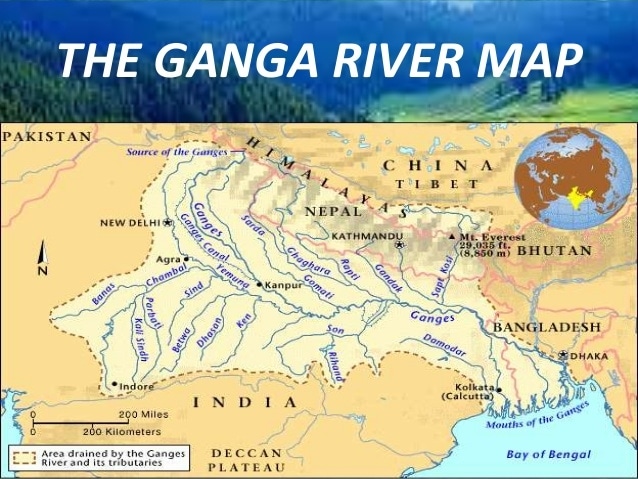15 Point Directive to Clean Ganga | 04 Oct 2019
The National Mission for Clean Ganga (NMCG) recently has issued a 15-point directive to the 11-Ganga basin states to prevent idol immersion into river Ganga and its tributaries and on their banks, including cordoning off the ghats.
- According to the directive, a fine of Rs. 50,000 would be imposed if immersion of idols took place in the Ganga or its tributaries during festivals, including Dussehra, Diwali, Chhath and Saraswati Puja.
- According to NMCG officials, the large-scale immersion of idols and puja material in the Ganga and its tributaries during festive occasions led to an alarming rise in pollutants in the river.
- The directive has been sent to officials of these 11 states namely- Uttarakhand, UP, Bihar, Jharkhand, West Bengal, Delhi, Himachal Pradesh, Haryana, Rajasthan, Madhya Pradesh, and Chhattisgarh.
- The Chief Secretaries of these 11 states have also been asked to submit an action taken report within seven days from the end of each festival.
- These directives were issued by NMCG under Section-5 of the Environment (Protection) Act, 1986.
Initiatives to Clean Ganga
- Ganga is a trans-boundary river of Asia which flows through India and Bangladesh. It is the longest river in India and is a lifeline to millions of people who live along its course.
- Causes of Ganga Pollution: The main causes of water pollution in the river Ganga are:
- Industrial waste (dumping of various harmful & untreated industrial waste into the river),
- Human waste (human activities such as bathing, washing clothes, etc.),
- Religious waste (religious bath, cremation near the ghats, idol immersion, etc.)
Initiatives to Prevent Ganga Pollution
- Ganga Action Plan: It was the first River Action Plan that was taken up by the Ministry of Environment & Forests in 1985, to improve the water quality by the interception, diversion, and treatment of domestic sewage. It also aimed to prevent toxic and industrial chemical wastes (from identified polluting units) from entering the river.
- National River Conservation Plan was an extension to the Ganga Action Plan, so as to cover all the major rivers of the country.
- ‘National River Ganga Basin Authority (NRGBA)’ was formed by the Central Government of India in the year 2009 under Section-3 of the Environment Protection Act, 1986. It is chaired by the Prime Minister of India.
- It declared the Ganga as the ‘National River’ of India.
- In 2010, ‘Government clean-up campaign’ was started to ensure that by 2020 no untreated municipal sewage or industrial runoff enters river.
- In 2014, ‘Namami Gange Programme’ was launched as an Integrated Conservation Mission, to accomplish the twin objectives of effective abatement of pollution, conservation, and rejuvenation of National River Ganga.
- The program is being implemented by the National Mission for Clean Ganga (NMCG), and its state counterpart organization viz., State Program Management Groups (SPMGs).
- It is the flagship programme of the Union Government with a budget outlay of Rs. 20,000 crore.
- The main pillars of the programme are:
- Sewerage Treatment Infrastructure & Industrial Effluent Monitoring,
- River-Front Development & River-Surface Cleaning,
- Bio-Diversity & Afforestation,
- Public Awareness.
National Mission for Clean Ganga (NMCG)
- It is the implementation wing of the National Council for Rejuvenation, Protection, and Management of River Ganga also known as National Ganga Council (set in 2016; which replaced the NRGBA).
- NMCG was established in the year 2011 as a registered society.
- It has a two-tier management structure and comprises of Governing Council and Executive Committee.
- The aims and objectives of NMCG are:
- To ensure effective control of pollution and rejuvenation of the river Ganga by adopting a river basin approach to promote inter-sectoral coordination for comprehensive planning and management.
- To maintain minimum ecological flows in the river Ganga with the aim of ensuring water quality and environmentally sustainable development.
- Ganga Manthan- It was a national conference that was held in 2014 to discuss issues and possible solutions for cleaning the river. The event was organized by the National Mission for Clean Ganga.
- In 2014, Clean Ganga Fund was also formed for cleaning up of the Ganga, setting up of waste treatment plants, conservation of biotic diversity of the river, and development of public amenities (activities such as Ghat redevelopment, and Research and Development and innovative projects). This fund will also be used to finance National Mission for Clean Ganga (NMCG).
- In 2017, the National Green Tribunal banned the disposal of any waste in the Ganga.
Way Forward
- Suitable alternative arrangements for idol immersion must be made in an environmental-friendly manner in order to preserve and conserve both the religious beliefs & sentiments and the environment.
- The concerned authorities must ensure effective monitoring and strict enforcement of the enacted rules and regulations.
- Even though the government has claimed that significant progress has been made, the data from the Central Pollution Control Board (CPCB) from earlier this year (2019) stated that water from River Ganga at several stretches is still unfit for direct drinking and bathing. So proper auditing and reporting must be done to take relevant actions.

